History of Britain and Ireland
At least 80% of our ancestry comes from the islands of Britain and Ireland, so I've made
this entry to put the history of this part of the world into the context of our ancestors.
History is the primary basis of all my genealogical work, so there is some overlap with the
surname pages, but there's no focus here on any particular family line. I don't claim to
be an expert on any specific topic, so keep in mind that my takes might be flawed. My
object is to paint a general picture and point out events that had significance to our
ancestors. I've lumped several significant subjects into this document. Basically if it
occurred in Britain and Ireland (and I'm aware of it) it's covered, and quite a few related
subjects will come up that didn't occur in the Isles but impacted them.
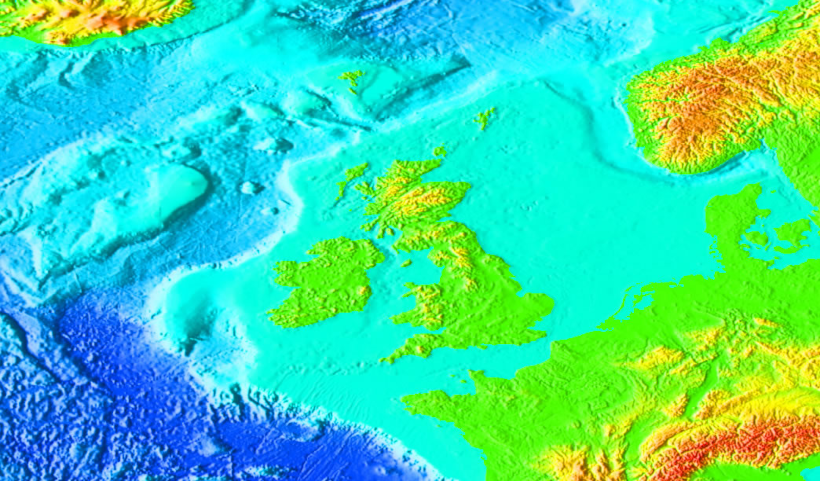
The British Isles
Before the Celts
The earliest habitation of Britain by hominids (predecessors of homo-sapiens) was 900,000
years ago. Practically a million years. These were the most recent known common ancestors
between humans and Neanderthals, and went extinct also a very long time ago. The Neanderthals
arrived in Britain around 250,000 years ago. They're believed to have become extinct
about 40,000 years ago. They weren't all killed by humans. We carry their DNA even today,
somewhere in the single digits percent. It's significant, more common than several strains
of DNA that I give a lot of attention to in the documents on this site. So, there was some
production of offspring between the two species, and basically the Neanderthals were subsumed
into the human race. It wouldn't be the last time that such an absorption occurred.
Climate change will become an ever-escalating concern for the modern world. In the historical
context, the Earth has had what we call "ice ages" every 100,000 years or so. These have
occurred many times while human-like beings have been in Britain. The Isles are fairly far
to the north on the globe, so when there was more ice and lower oceans, glaciers engulfed
what would come to be called Britain. In those times it appears that humans and pre-humans
withdrew to southern europe, i.e. the Mediterranean. Even though humans have proven that
they can survive in extreme cold, glaciers are not a stable thing to be on top of. What
really determined the movement of humans was the movements
of animals. All of these early peoples were hunters and gatherers, and they followed herds
of game. But anyway, the most recent "glacial maximum" was about 12,000 years ago. The
pattern these ice ages have followed is a relatively slow cooling and increase in ice and
lowering of oceans, and then a relatively quick warming (a few thousand years) and rising of
oceans. What ultimate impact modern humans will have on this process is yet to be seen.
The reason why I chose the image above for the British isles is to show how relatively
shallow the water is between them and Scandinavia and mainland Europe. Up to about 9,000
years ago, when oceans were lower, there was a land path to what would become England.
12,000 years ago, as stated, it was all covered in a glacier anyway, but there was a window
of a few thousand years where there were no Islands and it was all more habitable. Waterways
haven't stopped human migration, especially not in this timeframe, but there were no barriers
even to land animals during this time. The former land between Scotland and Denmark is known
today as Doggerland, and was a place of a lot of human activity that's been uncovered by
archaeology on the floor of what's now the North sea. It wasn't fully submerged until about
6,000 years ago.
Modern humans entered Britain around the time the latter became extinct, 40,000 years ago.
This was in a window of time before the glacial maximum, and these people were evidently
then displaced to the Mediterranean as previously described. It wasn't until that time that
humans were known to have entered Ireland, 12,000 to 10,000 years ago. The geographical
position of Ireland, being farther away from the mainland, but more importantly having a
colder climate, set developments to always arrive there later, as will be seen over and over
again. So, were any of these aboriginal British humans our ancestors? It's actually
possible. The U2 mitochondrial haplogroup was definitely part of these people,
the Cro-Magnons, entering via modern Ukraine. Based on the distribution map of U2 below, it
looks like it entered Britain and Ireland specifically with the Angles and Saxons, etc
beginning in the 5th century AD. So, when the last glacial maximum ended about 12,000 years
ago, U2s and others began moving north again, and ours evidently ended up around the borders
of modern Denmark and Germany when the Roman empire crumbled. I haven't researched other
X-chromosome lines, as I don't know what any of the rest of ours were.

But what about the Y-chromosome lines? We have ancestors from both major I-haplogroups, I1
and I2. The parent haplogroup of these two is called IJ, which entered Europe about the
same time as U2. All of our I-haplogroup ancestors were with this people. Our J-haplogroup
ancestors could've been part of them too, but it's highly unlikely. Most likely they
remained in the Middle-East at least until agriculture was developed. I1 split from IJ
about 35,000 years ago. They had little impact until agriculture was adopted by a portion
in Scandinavia, about 5,000 years ago, and that's the source of the vast majority of I1s in
the world today, including our I1 ancestors. Ours migrated to Ireland and Scotland as
Vikings, and later as Angles and Saxons etc and then Normans, mostly to England. I2 emerged
about 30,000 years ago and was more prominent throughout Europe, especially in a swath from
the Balkans into modern Russia. Our I2 lines very well could'be been part of the aboriginal
people of Britain who returned when the ice began to recede about 12,000 years ago. It's
possible that I2s came to Britain with the Angles and Saxons or later the Normans, but it
doesn't follow an associated pattern like female U2 does.
There are competing theories about when the bulk of the R-M269 haplogroup arrived in Britain.
What's certain is R1a and R1b were in modern Ukraine when the ice receded. My belief is the
majority of our R1b ancestors were in Britain at least 4,000 years ago. Some theories have
them invading more than 1,000 years after that and replacing most of the people who had been
there. I tend to believe that our ancestors were much more adapters and absorbers of new
culture than sword wielding murderers who slaughtered indigenous people.
The agricultural revolution began in the Fertile Crescent also about 12,000 years ago, and
in about 4,000 years it had spread to Britain. Remember that Britain was still connected to
the mainland at that time, though water would've been no particular barrier. Farmers from
Anatolia are believed to have followed two different paths westward: along the Mediterranean
and also along rivers into what would become Germany and France. It's believed that the
olive oil diet of the Mediterranean and the butter-based one in northern Europe were
established at this time. The first known civilizations were forming in other places, but
the agricultural revolution had a transformative effect in Europe as well. In the area of
the first European empire, Greece, an agricultural economy existed from about 9,000 years
ago, yet this people bore little resemblance to what would be recognized as Greek. Similar
economies formed wherever agriculture was established.

Spread of agriculture in Europe
Prior to this, the hunter-gatherers,
some of which were probably our ancestors, resembled nomadic tribes that can still be found
in Africa today. They had a choice now to adapt to the new culture, and I expect that they
were generally reluctant. But while as farmers were settled, they also grew larger populations.
Therefore those aboriginal peoples who didn't join them would become extinct one way or
another, by conflict or by simply becoming outnumbered and subsumed like the Neanderthals
had been. While the development of agriculture was a large step in the direction toward
the way we live now, these early farmers still would've been savage to us, with practices
such as human sacrifice. They were much darker in complexion than modern Europeans as well,
even in Britain. I presume that the R1b men looked more like modern Europeans, and came in
later waves of pre-Celtic farmers.
The last subject to cover in this section is the construction of Stonehenge, though it
overlaps chronologically with the development of Celtic culture in mainland Europe. I
don't think that the nomadic aboriginal people of Britain built any kind of megalithic
structure. This was something that developed with agrarian culture, when people stopped
migrating and began to think about life in a different way. When they stayed in one place,
they began to have thoughts of ornamentation of the land. I don't know if nomadic peoples
made use of the stars or the moon. Naturally the sun was fundamental, but I suspect they
navigated more by land formations, if they weren't crossing the open sea.
It was the settled peoples who started building
things with a degree of permanence. Stonehenge of course is a famous example of megalithic
structures. But it was first built of wood, and stone construction began about 4,500 years
ago. It took about 1,000 years to complete. The builders were the first farmers in Britain.
Predominantly they came from Anatolia, and they were of the G Y-DNA haplogroup.
With them were I1s, I2s, J1s, and J2s. This is the default explanation for how our Scott
J2 Y-DNA came to Britain. If that's true, it's possible that they were involved in the
construction of Stonehenge. They were rare, and of course only a fraction of Britons were
involved. Aside from the fact that I believe they came with the Romans, the chances of
building Stonehenge are small. The same applies to our I2s. Considering the dominating
effect of Vikings and Germans on our I1s, it's highly unlikely that any of them were in
Britain this early. It seems to me that R1bs were in Britain in large numbers before
Stonehenge was completed, but I'm not aware that R1b has been found in human remains around
the site.
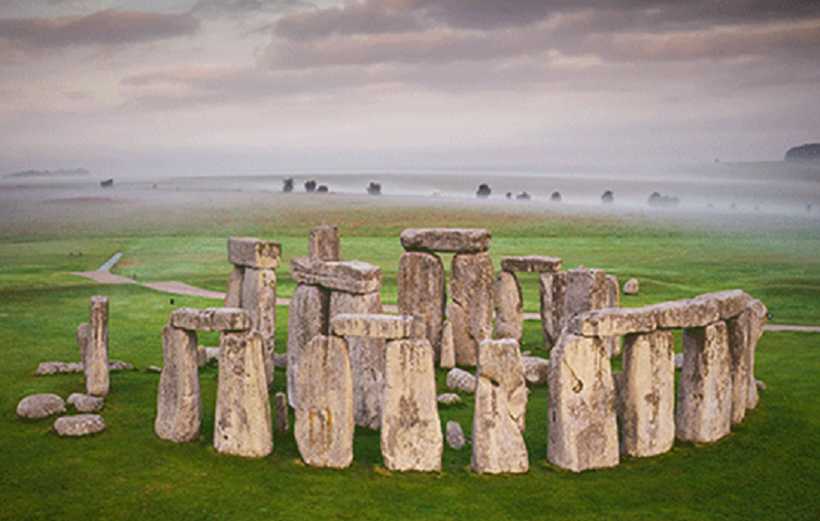
Stonehenge
The Celts
The term Celtic is primarily associated now with Ireland, as the Gaelic language remains
as a cultural legacy of the Celts. But Celtic actually is a very broad term, a culture
that developed in mainland western Europe and spread to Britain and Ireland. Highland
Scotland, Wales, Cornwall, and places in Europe from Spain to Turkey still show some
remnants of the Celtic language. France has its roots in Celtic culture, and it had a
lot to do with why the French language is so distinctive within European languages. The only
certain connection for us is Gaelic, Catholic Irish, which is significant but definitely a
minority in our ancestry. The other connection is genetics, the R1b Y-DNA haplogroup.
Like all western Europeans, the majority of our paternal lines were R1b. I don't believe
that all Celts were R1b, as Celtic was a culture and anyone can adopt a culture, but
certainly there's a very strong correlation between R1b and the Celts. Very likely over
95% of Celts were R1b. But since R1b is so prevalent in mainland Europe, it could've come
to Britain with the Angles and Saxons etc or even the Normans. I doubt there ever will be
a way to prove where a given R-M269 line came from, but I would guess that the majority
had been Celts and were already in Britain when the English and Normans came. English and
Norman are also cultures, and though they had strong genetic connections, I believe that
more Celts in Britain converted to new cultures than had to be killed or driven to Ireland
or something. I expect that most of our R1b ancestors were in Britain
before even Celtic culture arrived.
Celtic was part of what's called Indo-European culture. This concept is based mostly
on linguistics, that there are similarities in languages from Calcutta to Derry that
clearly point to a common origin, hence India-Europe. Given that a common culture is the
fundamental evidence, determining where it came from will probably always be conjectural.
Two primary theories put forward place the origin somewhere in the middle of this range, one
in Anatolia and the second and most supported to the north of the Black Sea. This latter
theory is called the Kurgan hypothesis, named after the burial mounds used by a culture
that began about 5,000 to 6,000 years ago. I'm very interested in the concept of
Indo-European, but I'm not an expert on it in any way. I'm aware that in India it's
fashionable to believe that the common origin was in India. This is partly in resistance
to the origin of European scholarship on the subject, which began in the late 19th century.
This is where the concept of Aryan came from, and Christian theology played into it, and a
European nationalism and sense of superiority.
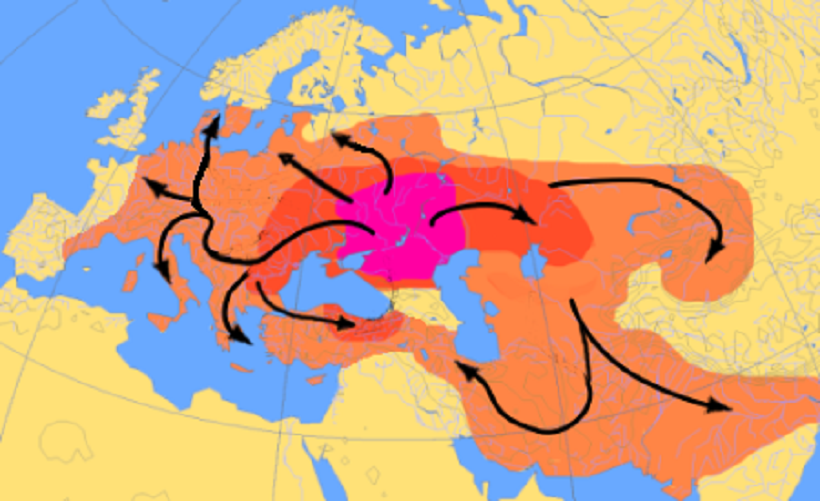
Kurgan hypothesis
In terms of genetics, there are competing theories of the path that R1b took to
come to Europe, but I think there's a clear connection between R1b and Indo-European,
certainly in Europe. One theory is that R1b came through the Middle East, maybe up to the
Caspian Sea, and then spreading from there, finding most impact in western Europe. The
other theory is that all of humankind tended to migrate initially eastward out of Africa
because of the last Ice Age, and the predecessors of the R-haplogroup were actually in
northern India. The peoples who were in Europe before about 15,000 years ago were not R1b.
Regardless of the two theories, R1b went north of the Black Sea like Indo-European culture.
To me the question of the precise location origin of Indo-European culture is when
it happened. If it was 4,000 to 6,000 years ago, then the Kurgan hypothesis is probably
accurate. If it was earlier, especially much earlier, it could very well have originated
in India or somewhere between India and the Black Sea.
Regardless of where Indo-European culture began, where it went is quite obvious. And
though there seems to be a connection to the R1b haplogroup, and R1a, the spreading of
culture isn't always connected to genetics. The pattern I see in the history of
Indo-European culture is one of a ruling class. Indo-European culture moved through a
vast area, and all of it had been already populated by a variety of peoples. They were
farmers and pastoralists, and so also were the Indo-Europeans. I tend to think this spread
wasn't like the Romans conquering Gaul for example, but more peaceful, because it was so
early in the formation of civilizations and kingdoms. That said, the development of
bronze and iron technology, and horseriding, are known to have been fundamentally
connected to the Indo-Europeans. So, regardless of how the spread of the culture played
out, it was a conquering of the native peoples in at least a cultural sense.
Getting back to our ancestors and the European theater of the Indo-Europeans, the Celts
were one (or a few) of the identifiable cultures that developed from the common origin.
Another is Germanic. The Greeks were Indo-European and were the first major empire of
Europe. And then later came the Romans. The Greek theater of activity was to the east,
as western Europe at that time was a patchwork of a variety of Indo-European cultures.
It seems to me that what distinguishes Germanic culture from Celtic is the former
learned (maybe from the Romans) the value of uniting various tribes into a more powerful
entity. Celts were capable of growing larger kingdoms, as evidenced by Gaul, but I think
for the most part they ended up being dominated by other powers due to a tendency
to isolation that was integral to their culture. Also consider the colder weather in the
northern and western extents of Britain and Ireland, and the inherent delay in development
arriving there as mentioned previously.
But let's take a step back to where we left off in the timeline of European history that
would spread to Britain. A variety of cultures have been identified from modern France
and Germany to Ukraine via archaeology that are connected to Indo-Europeans and were
precursors to the Celts. By 4,000 years ago they had spread to Britain and Ireland,
including lots of R1b men in my opinion, maybe the majority of our R1b ancestors.
The definition of these cultures is usually based on their style of pottery and how they
buried their dead. The arrival of Celts in Britain is placed at around 3,300 years ago,
pretty much just after Stonehenge was completed, and it didn't take root in Ireland until
another millenium later, a century or two before the Romans came. As elsewhere Indo-European
cultures spread, the Islands had already been farmed and grazed for thousands of years.
Specifically in this case, where terrain was limited, Britain and Ireland had already
been largely deforested. The Celts had the advantage of iron technology, which probably
was held as a source of power by the ruling class and thus spread the culture. The map
below shows the extent that Celtic culture reached, with the yellow being where it
originated, and the darkest green where Celtic languages are still spoken.
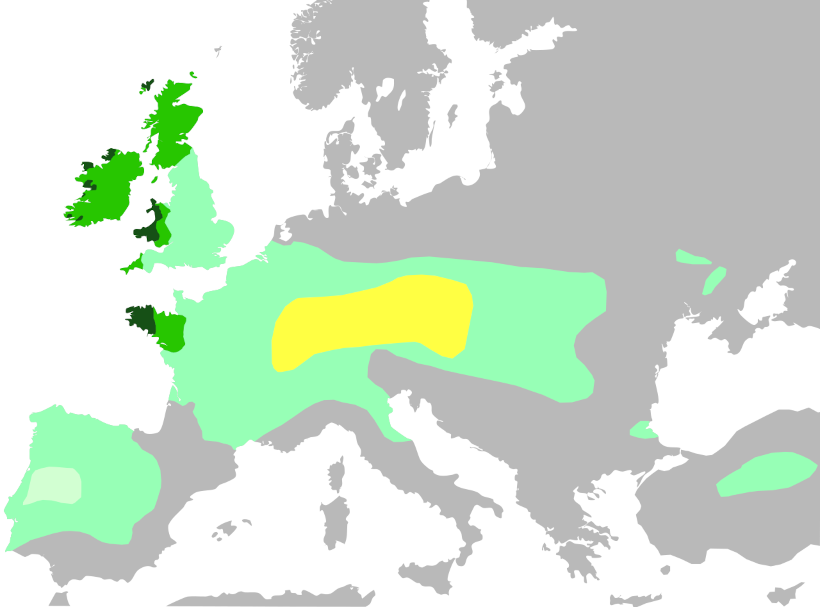
Celtic culture
As human civilization developed, this kind of "invasion" of people and culture became
more complicated, and the idea of an "aboriginal" people became less applicable. But I
tend to believe that our ancestors were more "native" than "invader" and adapted to
cultural changes, because I don't think there tended to be population replacements in
the waves of new peoples and cultures that would continue to come. When the "indigenous"
people became less numerous after an "invasion", I tend to believe this was more due to
being outnumbered and having a shorter lifespan because of their mode of living, than
having been killed by the invaders. It's probable that
men of the R-M269 haplogroup had begun to come to the Islands before formal Celtic
culture did, and the adoption of Celtic language in Britian and Ireland was even more of
an adaptation than a relatively sudden migration of people. Migration of peoples into
Britain probably wasn't the norm over the coming centuries, and I think commerce
became the driving force of events. Commerce creates wealth, and wealth is power, and
power leads to struggles between different chieftains and the peoples they belong to.
The Celtic peoples of Britain and Ireland, which was more of a cultural thing than a
genetic one, formed into tribal territories. The most valuable land was in the south of
what would become England, which was the best farmland due to its warmer climate.
Farther north and in Ireland, the tribes weren't completely isolated, but much moreso. In the south
there was much interaction with the mainland, and this was affected more and more by the
larger developments that came from the Mediterranean.
The Romans
I had thought to make an entirely separate document about the Roman Empire, as there's
so much that can be written about it, and I believe we had Roman ancestors who came to
Britain. But my objective is to keep on the track of British history, so I'm limiting
the Romans to one section here. The origin of Rome fell into the mythic past for the
Romans, but the Greeks claim that it began as a colony started by them. The Greeks
were the first to name the British Isles, calling the lands Albion somewhere around
2,600 years ago. This was the beginning of the written history of Britain. Albion was
the root of Alba, the name of the later kingdom from which Scotland arose. The term
Celt was coined by the Greeks. A Greek called Pytheas from what is now Marseilles
France, voyaged to Britain about 2,300 years ago. He got the name Pretani from the
native Celts for themselves, which meant "painted people". From this the Romans later
named the main island Britannia, with the 'p' shifted to a 'b'. They called Ireland
Hibernia, which didn't come from a Celtic origin. The Romans translated Pretani to
Picti, which was applied by them to the Celts in the highlands of Scotland. From picti
comes the word picture which is familiar to us now. By modern artists the Picts are
depicted, as it were, as being painted blue. Apparently some kind of tattoing was
common with all Celts, at least in Britannia, and I expect it wasn't quite that colorful.
Getting back to Rome, archaeology shows that settlement there began about 3,000 years ago.
This began to ramp up in a couple hundred years, and the Roman kingdom was born. The
oldest discovered Roman writing about the kingdom period is about 2,600 years old.
Putting this into context, Britain had aleady been Celtic for almost a millenium. The
Roman republic was formed 2,500 years ago, and lasted almost 500 years. The kingdom
before the republic had a senate, and it selected a king from amongst themselves. The
first change entering the republic period was to eliminate the monarchy and have
elections for a magistracy. This was no democracy of course, as only the senate
voted. Roman power began to expand before the republic period, and gained momentum
during it. This brought them into conflict with Celtic tribes to their north and west
in the mainland. As the republic began, hill-forts became common in Britain and the
mainland. This no doubt was a reaction to the expansion of Roman power. But the Celts
were also growing in power, particularly in Gaul, which is the model of what might've
been with Celtic peoples if Rome had never existed. The kingdoms of Gaul were much larger
than those in Britain and Ireland. But as the Romans continued to expand, they
conquered the Celts of the mainland, leading up to the founding of the Roman empire
about 2,100 years ago.
We're coming up on the common era now, and Rome began to think of the riches that could
be gotten in Britannia. As previously mentioned, southern Britannia was very much
connected to their Celtic brethren in the mainland. Of our two paternal lines which I
have high confidence came from the Romans, their lands about 2,100 years ago were
conquered elsewhere than western Europe. Our J2 Scott line came from Syria, the eastern
end of the Mediterranean, and our E2 Hollis line came from Mauretania, the western end
of the Mediterranean on the African side. They both became Romanized in the coming
century or two before the Romans went to Britain. It wasn't as much of a change in
Syria, which had become thoroughly Greek in the preceding centuries. The map below is
looking a bit ahead, but it puts into perspective the breadth the Roman empire reached,
and the far-flung parts that brought a wide variety of people to Britannia.
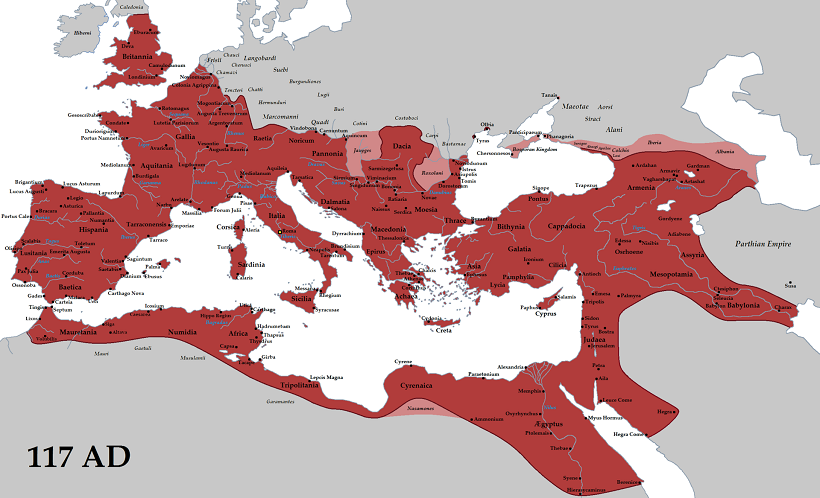
Roman Empire
Right at the time the Roman republic became an empire, their first invasions of Britannia
were attempted and failed. The Romans had client chieftains in the southern part, who
saw that arrangement as the best way to retain their power. But the people disagreed and
managed to drive out landings that didn't expect resistance. Still, in the year 43 a more
determined invasion was mounted and this planted the Romans in Britannia for the next
350 years and more. They systematically subdued the Britons, the Celtic tribes that had
taken their form over the past millenium. Boudica is a famous heroine of the Britons,
who was killed after a considerable rebellion in the year 60. Hadrian's Wall was built
around the year 120, establishing a demarcation of Roman control. But that said, while
active rebellions in future Wales and Cornwall had been quelled, only the southeastern
part of future England became fully Romanized. If the Romans' years hadn't been numbered,
given enough time their influence would've spread through all these regions and into
Ireland the same way that English influence did in the modern world. The Roman base has
a lot to do with England eventually becoming a world power. See the map below of the
arrangement of Britonnic tribes after Hadrian's Wall was built.
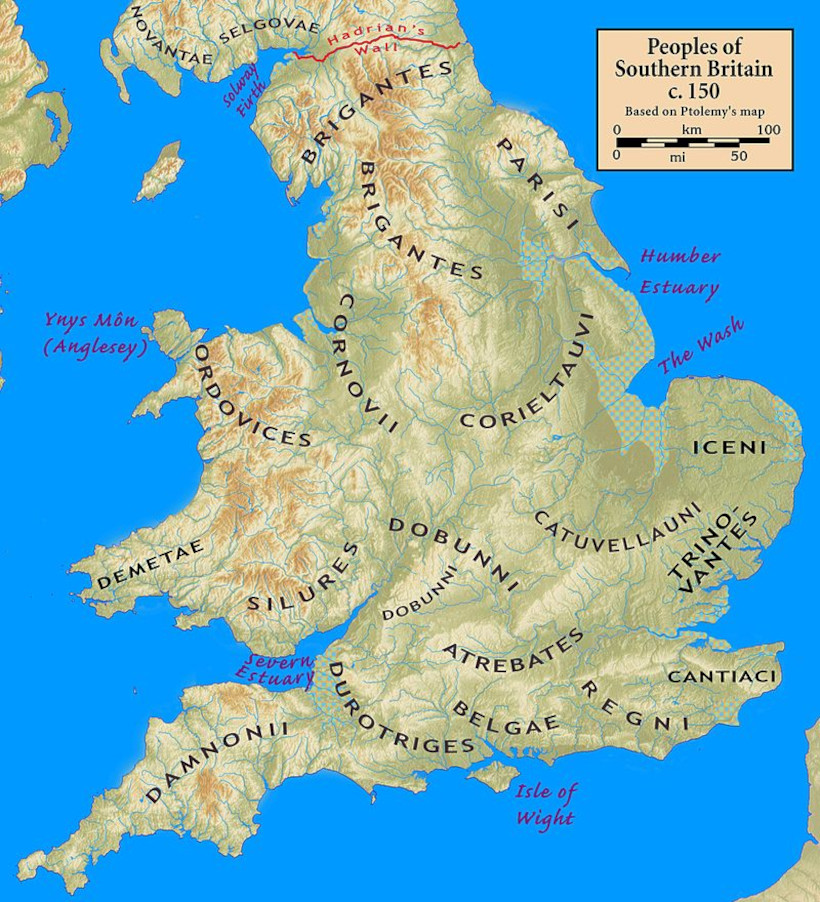
Though a real transition from republic to empire isn't as dramatic as, say, what's
portrayed in Star Wars, when the Roman empire was formed, it was corrupted and was
doomed to fall. It still took over three centuries for things to get so bad that the
Romans formally withdrew from Britannia in the year 410. Several big events in British
history were in motion then, including the introduction of Christianity. Christianity
was foundational to Ireland, maybe more than any country that ever existed. It came
there about the same time that Gaelic culture emerged out of Celtic. Germanic
mercenaries were in Britain before the Romans left, and that set the stage for a
transformational movement into a power vacuum. It wouldn't be the last time. While
only the southeast of England became fully Romanized, the impact of that period remained
all over. Forts were maintained for decades at least. Latin was used in churches and
government north of the Wall, and in Ireland. Latin remained the language of education
in England.
The Roman Wake
The Roman empire had a large impact on most of our ancestors, in that time. Of course
Rome remained the seat of Christendom for all of our ancestors for a thousand years
afterward. It took some of them a few centuries to convert, particularly the Germanic
tribes from around modern Denmark and northward, but though our ancestry came from some
unexpectedly diverse origins, in the wake of the fall of the western Roman empire they
were all now in Christian Europe. The vast majority of our French, German, and Swiss
ancestors were the most entangled in it. The Merovingians arose, when Germanic chiefs
took over in central Europe. See the map below. A lot of our ancestors were in the
area marked 'Saxons', particularly those who would move to found England. We will get
to them. A small few were in the Saxon region who would remain there like the others
who were now Franks, until they came to America. A split would occur amongst the
Franks in the coming centuries where the kingdom of Germany was formed (843) and then
it became part of the Holy Roman Empire, unified with Italy and the Vatican. This
arrangement wasn't dissolved until long after our German and Swiss ancestors had
departed for the New World.
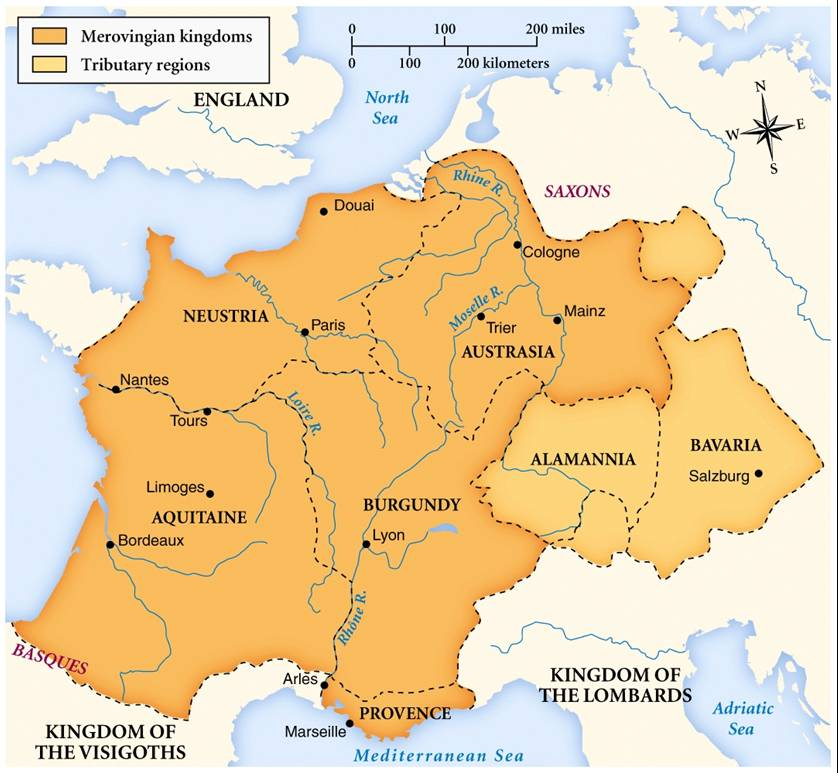
Most of our ancestors in what would become England were thoroughly Romanized. Some were
in Ireland and were utterly Gaelic. A few were in Cornwall and
Wales. A few were in the Scottish highlands and were very much like the Irish. Quite
a number were in the area of Hadrian's Wall. These are interesting because some were keen
on being rid of the Romans, while many likely were sympathetic and attempted to maintain
forts and whatnot. But let's get to the power base that would come to create a global empire.
As stated previously, upon the withdrawal of the Roman military from Britannia in the
year 407, British leaders summoned Anglo-Saxon mercenaries to guard against Celtic raids,
particularly by the Picts of highland Scotland. These mercenaries were given territory
for this, I would guess around Norfolk and Suffolk. Probably related to the dissolution of the Roman
empire, conflict between the Britons and the immigrating Anglo-Saxons eruped in 442. This continued
until the year 500, when the rebellion was put down. Now keep in mind that Germanic
peoples hadn't been utterly foreign to Britain previously. There were German soldiers in the Roman legions.
They likely engaged in trade with Britain throughout the Roman age. Germanic peoples
were on the rise and played a large role in the fall of the Roman empire.
The momentum of the Germanic migration into the mainland around Britain is what helped
them to mount an invasion of Britain in a sort of parallel to the Roman invasion centuries
before. But while the Romans were a massive empire with deep resources and sought to
annex the entirety of Britannia, the Angles and Saxons and Jutes and Frisians etc, while
they defeated the British ruling class, they had no empire to add land to and simply
rooted themselves in eastern Britain. The Angles and Saxons were the most powerful, and
their culture was the one now established as the ruling class, at least in the area they
controlled. The Roman legacy remained, I think, and it merged with Anglo-Saxon culture
to form something distinct from the lands they came from. As for what portion of our
English ancestors were invaders and what portion were native, as I've said I believe the
latter group was much larger. Surely the number of Germanic peoples who migrated to
Britain at this time was significant, but I don't think the portion of them that were of
the R1b haplogroup was comparable to those who had already been in Britain before the Romans.
The Old North
As the Angles founded kingdoms in eastern Britain from modern Edinburgh to Birmingham to
Norwich, and the Saxons in southern Britain from Exeter to Bristol to London, in Ireland
and Cornwall and Wales and western Britain up through the highlands, Celtic tribes
remained as they had been when the Romans landed, and they had survived and were as
strong as ever, if modified and affected by changes within. Still, there was no movement
to unite into one nation against the new invaders. But while there was conflict between
Celtic tribes, there was also kinship over large areas. One of these was, before the
Romans came, from what is now northern Wales through Carlile and Glasgow, eastern northern
England and Scotland. Though the Romans impeded the land connection between Wales and
their northern kin, they remained in contact. In Wales they called their kindred tribes
there the Old North, or Hen Ogledd. See
the map below from the year 550. The Angles formed two kingdoms from the east coast,
Bernicia which took its name from the Celtic kingdom Brynaich, and Deira from Deifr.
Three other Celtic kingdoms of the Old North were prominent in the wake of the Roman
withdrawal, including Elmet which was absorbed into Deira and Gododdin which was absorbed
into Bernicia. The land northwest of Rheged became the kingdom of Strathclyde. That and
the also-kin kingdom of Dal Riata in the eastern highlands were fundamental to the
eventual formation of the country of Scotland.
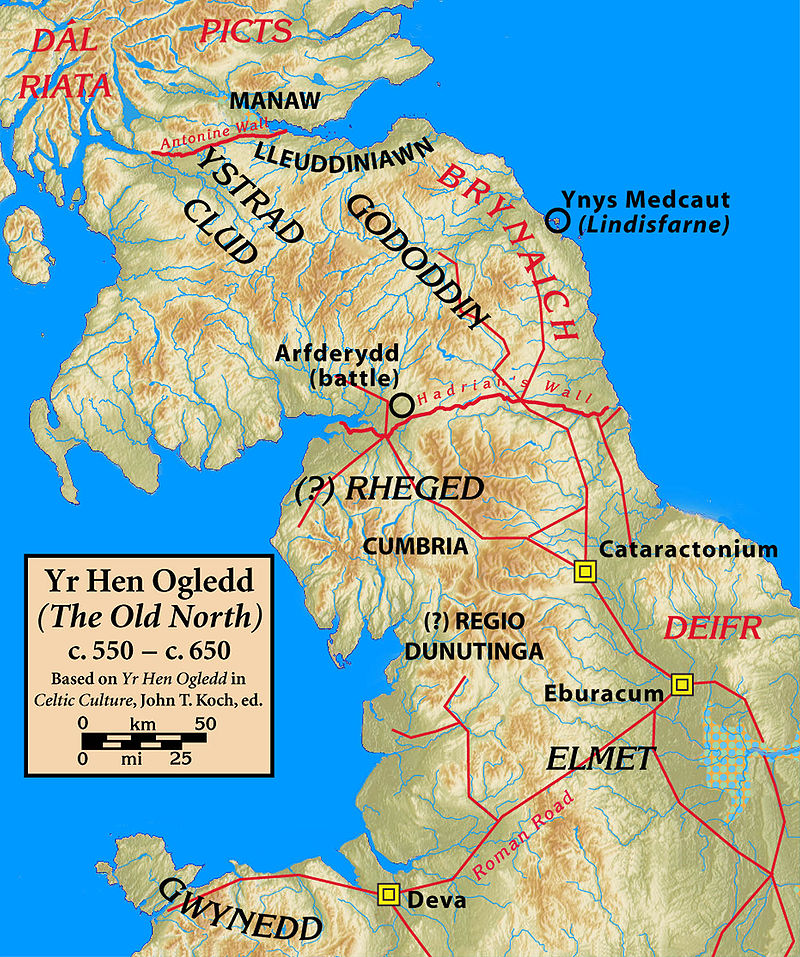
The Danelaw
The England we know today didn't form in a simple process. Hardly. First, several tribes
shaped the country, including Brittonic ones, yet the name and language came from only one,
the Angles. The Germanic tribes that came in had no grand plan to form a country. They
hadn't come from a country. The concept of England took several centuries to develop. Of
course the Angles and Saxons were the most prominent and formed the ruling class. The map
below shows how the two had solidified control of most of what would become England. The
Northumbrian kingdom was probably the most formative of our ancestors, even the Scottish
ones, as you can see that it stretched all the way to Edinburgh (Lothian). While highland
Scotland came from Gaelic culture, the eastern lowlands didn't. Remember that most of the
area of future England had been thoroughly Romanized, except for the western extreme of
Saxon territory and approximately the northern half of Northumbria. It took longer for the
western part to formally merge into England, especially Wales, and even Scotland became
part of the United Kingdom eventually. As I said before, I think the Roman influence is
what set the course for England to be the dominant power of Britain, but the Celtic influence
had a lot to do with the cultural character.
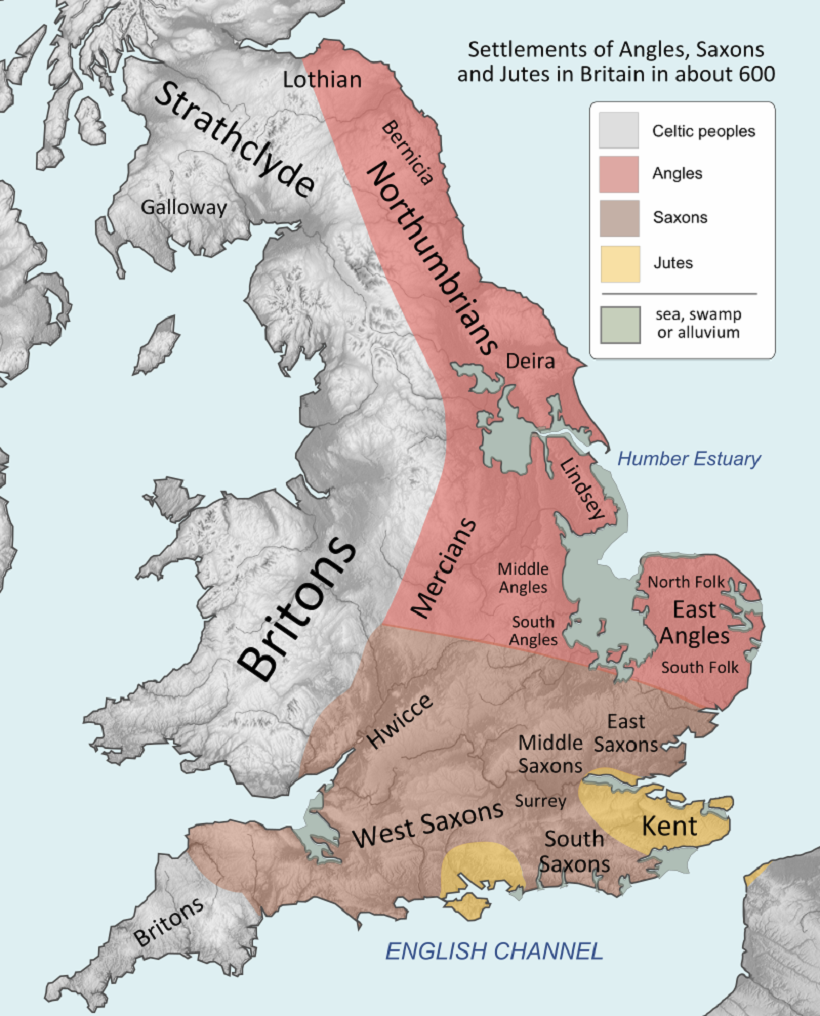
The fact that Norfolk and Suffolk today come from what was called East Angles shows that the
Angles and Saxons were definitely not originally united, as Saxon territory clearly formed a
separation. It was just after this time that the land became Christianized. It was the
Irish who drove the process, and it spread from the north to south. As was the case throughout
Europe, many pre-existing practices were adopted into the religion, and the full transformation
took centuries to complete. There was still no unity called England, but the term English
for the common language came into use by 731. It seems that it was called English and not
Saxonish or something else, because of the Britons. Because they always called the newcomers
Anglo-Saxon, with Anglo- always before Saxon, the term was shortened to just Anglish, or
English.
Though the Anglo-Saxon immigrants defined the language and eventual title of a country that
would form, it had yet to happen when a new wave of immigrants came and had a similar affect
to what the Anglo-Saxons had done. Vikings were Germanic immigrants coming from Scandinavia,
just north from where the Anglo-Saxons did. They probably came for similar reasons: increasing population and pressure from
an inhospitable climate compared to the south. The Vikings have a reputation for having been
more aggressive, pillaging and plundering. But they also settled. In the same migration
period, they settled Iceland, were the foundation of Russia, took over Normandy in France, and
even attempted to settle North America. It was in this period that our Scandinavian
ancestors settled in England and Scotland. They founded Dublin in Ireland and the major towns
around the southern coast, though I don't think we have any Scandinavian lines from Ireland.
The Vikings were not Christian, which probably is the foundation of their barbaric reputation
from the English perspective.
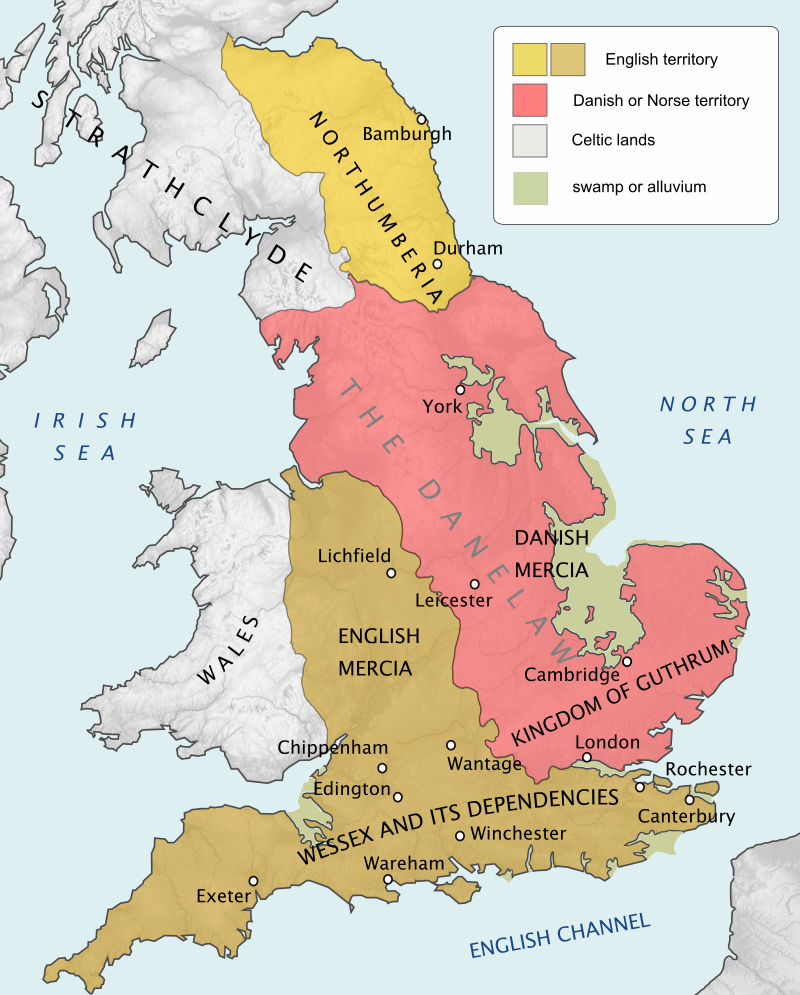
Britain in 878 AD
The map above shows the impact the Vikings had by the year 878. They conquered kingdoms of
the Angles primarily, leaving only a portion of Northumbria. What would become English was
basically the Saxon kingdom if Wessex in the south. The non-Christian Danes ruled a vast
area that was called the Danelaw, I guess by Wessex. They came mostly from Denmark.
Cornwall had now been incorporated by the Saxons. Wales remained as its own entity, as did
Strathclyde in the Old North. I'm sure that some of these Vikings were our ancestors, but I'm
not sure if most of ours came from the Danelaw or the Normans. As happened elsewhere with
the Vikings, they eventually merged into their new country. They became Christians and were
part of the formal unification of England in 927. They had an impact on the English language,
which isn't as noticeable as what would occur later because Old Norse was also Germanic. So,
though the Anglo-Saxons had been there centuries before, the Danes weren't that foreign and
were simply another warring Germanic tribe that made up what would become England.
The Norman Invasion
The now-established country of England existed for just over a century before another Germanic
invasion occurred. This one spoke French, because the Vikings who went to Normandy (which
was named after them, North-men), became French like the Danes had become English. In the
year 1066 the King of England died, and it triggered a succession crisis. William of Normandy
saw the opportunity of taking the kingship himself, and he led a force across the Channel that achieved it. The
bringing of the French language probably in the end had the biggest effect. Our ancestors who
have French names obfuscate whether they came to England with the Normans or if they simply
adopted Norman names because the French language held sway in the nobility for many centuries.
Today's English language is a mixture of Germanic and Latin elements that makes every rule
have an exception. The Norman invasion was genetically confusing as well, as the Norman
ruling class was probably the Viking I-M253 haplogroup, but Normandy is predominantly R1b.
The Anglo-Saxons likely had a similar genetic makeup. My presumption, as I've stated before,
is that most of our R1bs came to Britain even before the Celts did, let alone the Germanic
tribes.
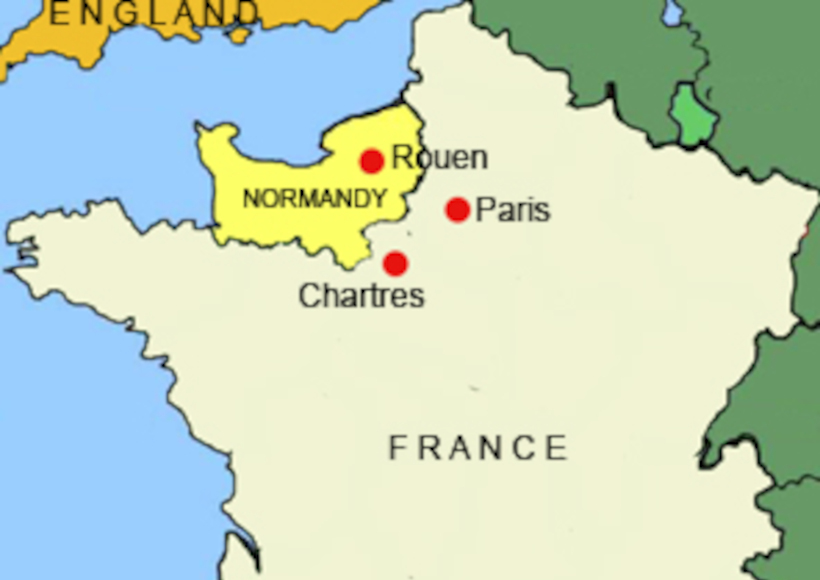
The Norman conquest, as you might have deduced, I see as a great disruption in English history.
That really is only due to the French language, and I see English surviving and eventually
reviving. The language is still called English and is more colored by French than to have
become a Germanic-colored Latin language. But the England we know really was established by
William of Normandy, as we know it by kings named Henry, which is a French name. A section in
this document on the Normans maybe should be larger than this one is, but as it stands, just
realize that Norman England is inherent to the story going forward.
Scotland
Let's go back now to the Old North and Strathclyde and Dal Riata, the former with a Britonnic
history that came into conflict with the Romans and survived, the latter a Celtic kingdom
founded by Irish immigrants. The formation of what became Scotland originated in the north.
The Picts were the most isolated group, even by Irish standards. The first step in this
formation was the merging of the Picts and Dal Riata. The Picts became Christians and also
began speaking Gaelic. Strathclyde then merged in, and in the 9th century the concept of the
king of Alba came to be, and the term Scotia, eventually Scotland. We have ancestors from all
four corners of Scotland, with more as you go through them counter-clockwise from the highlands.
This is no coincidence, as the southeast of Scotland is a region that was fought over between
Scotland and England for centuries before North America was colonized. Life was usually
difficult there, and that drove our ancestors to leave, often first for the
Irish plantations, and eventually to America.
The arising of Scotland occurred when the southeast part had been thoroughly Anglicized. Our
border region ancestors were never Gaelic speakers. Most of them had been Brittonic Celtic
tribes when the Romans came, and they spoke a precursor language to Gaelic. But what defined
them most by the year 1000 was the Anglish kingdom of Northumbria. As was covered before,
during the Danelaw Northumbria remained Anglish. What's called the Scots language is now
spoken in the lowlands, which reflects the influence of Gaelic on the English language in the
period where it became part of Scotland, not the earlier Brittonic language. The
instability of the border region would continue with the coming Protestant reformation.
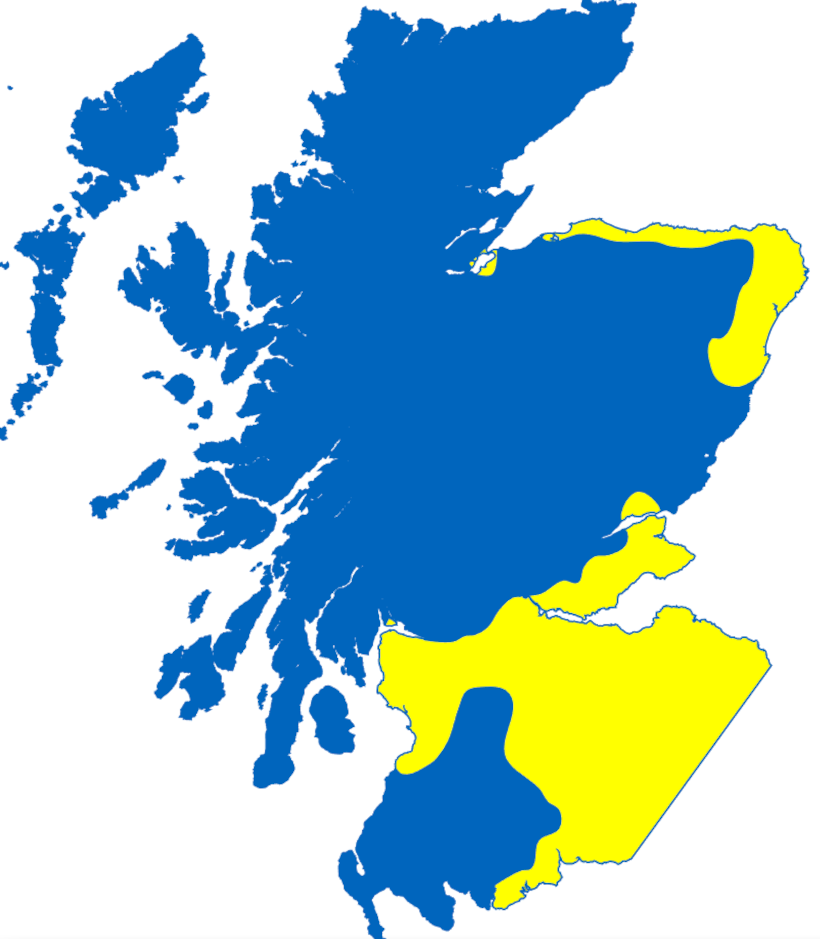
Languages of Scotland - blue=Gaelic, yellow=Scots
Ireland
The history of Ireland is fairly murky. The name Ireland was only formalized in the 20th
century. The origin of the name is uncertain, coming from a Celtic root or maybe even from
the name Hibernia that the Romans called it. As I stated before, my understanding is that
what we call Ireland was formed when it became Christianized in the 5th century. Of course
it had a history before that, which was defined by competing Celtic tribes. With the rise
of Christianity the territorial rivalries continued, now forming into kingdoms. At the
same time the Vikings began raiding and settling Britain and central Europe, they did the
same along the eastern and southern coasts of Ireland. Vikings came to rule Ireland similarly
to the Danelaw in England, and Normandy in France. When the Normans invaded England, unlike
the Romans, they also took control of most of Ireland, the groundwork having been laid by
their Scandinavian kin. And as happened everywhere the Vikings went, they enthusiastically
merged into Gaelic culture. Surely more could be written about Irish history, but though we
had several Catholic Irish ancestors, I know next to nothing about their deep history. Only
our McAtee line connects clearly to one of the Irish kingdoms, that of Airgialla, also called
Oriel. That would be worth learning more about.

Protestant Reformation
The Christian religion had a great impact on our ancestors from the time it was adopted in
the wake of Roman Britain, to the present. Certainly the belief systems that preceded it
were foundational, but I don't see obvious religious impacts on the historical trajectory
before Christianity. Probably before writing it just can't be known. There is archaeolgical
evidence of burial practices, and human sacrifice, which were part of the evolution to our
present sensibilities. The greatest impact on our ancestors that I can see before Christianity
was the agricultural revolution. Catholicism from the start was a unifying force, as far as I
can tell, forging Ireland as we know it, and spreading through all of Britain. It's likely that
the conversion process wasn't smooth at all, but in the end Christianity really established
Europe as a concept. Religion became integrated in the power structure of European kingdoms,
which became the source of great strife that is the narrative of the rest of this document, and
eventually drove emigration to America.
I'm not an expert on Christianity, nor the Protestant reformation, but I can see its impact.
There's a proverb that says "power corrupts". It's a proverb because it's true, even though
people will continually fail to realize it until it's too late, because power is seductive and
humans will insist on believing that they know better than everyone who's come before them,
that they won't be corrupted. Either that, or they just rationalize the corruption into
something beneficial. The concept of separation of church and state, as we call it in America,
is all about the corruption of power. The spiritual power of religion is corrupted into a
material power when it's integrated into the state. The state, as we've learned in America,
can already be corrupted by the power of wealth, without integrating it with religion. The
corruption of wealth consumes democracy and generates poverty and oppresses the poor. The
corruption of religion consumes democracy and oppresses those not of the chosen sect.
I'll take a step off my soapbox here, just one, as we go back to 16th century Europe. I'm not
going to attempt to understand what the Protestants were protesting, as I take no side, except
against oppression. We had Catholic ancestors, and of course the vast majority became
Protestant, and different sects slaughtered each other and oppressed each other over it. You
might notice that I greatly rue all of it. We have lines that in the past were at each others'
throats at times, yet eventually were joined together. To me it shows what an absurd tragedy
the past conflicts were. I see no value at all in any of it, unless they actually stopped
oppression without replacing it with only a different oppression.
But taking the other foot off, and getting back to what happened, Martin Luther in future
Germany catalyzed what would be the Reformation. Conflict there in the process led to the
immigration of all our German and French ancestors in the 18th century before the American
Revolution. But this narrative will return to focus on Protestantism in Britain. As you
probably are aware, in 1527 Henry VIII asked the Vatican to have his marriage annulled. When
the Pope refused, Henry decided to separate the Church of England from the papacy, which
established Protestantism in Britain. Though Luther's ideas had been recently percolating,
this was a completely poltical move and began a bloody power struggle that greatly affected
all of our British and Irish ancestors for centuries to come. I truly don't know how things
would've played out if not for Henry VIII. It seems unlikely that all of Britain would've
remained Catholic, but I think it's possible. Henry's move seems to me to have ended Norman
England and guaranteed future strife with Ireland.

Henry VIII
We'll come back to England, as the religious struggle there was fundamental to coming events,
but let's now look at Scotland. As was stated before, Gaelic Ireland was rooted in
Catholicism, maybe more than any other people. I don't know what all the dynamics of the
development of Presbyterianism were. I do see it as less corrupted than the Church of England,
coming from maybe a more spiritual origin. But this could only be due to Presbyterians not
having the opportunity to merge with the state, like the Church of England. One thing I do
rue very much about Anglicanism is its correlation with the practice of slavery. I'll never
accept any religious excuse for the very worst form of oppression that humankind has ever
conceived. Presbyterians didn't approve of slavery, but I do believe there were exceptions
in America. Ireland had a pull on Gaelic Scotland, and I'm not sure to what extent or speed
it converted to Presbyterianism. But the lowlands followed England in the Reformation.
Given that this happened after Henry VIII's gambit, political influence on the development of
Presbyterianism can't be denied. Regardless, Protestantism was planted in Scotland, and for
the moment, all of Ireland was Catholic.
It may be impossible to understand all the dynamics behind the coming turmoil. What I'll do
going forward is focus on how England was ruled without digging too deep. Henry VIII's first marriage
produced one surviving child, a daughter named Mary. England had only had one queen and Henry
was determined to have a son. When he succeeded in annulling his marriage to Catherine of
Aragon, it made Mary illegitimate and he wed Anne Boleyn. The only surviving child of that
marriage was a daughter named Elizabeth. Henry had Anne executed and Elizabeth declared
illegitimate, then he wed Jane Seymour who gave birth to a son named Edward. Jane died from
that birth, and Henry died in 1547. Scotland declared war twice on England in Henry's time,
and both times Scotland was defeated. Henry's son became Edward VI, and was nine years old
when Henry died. Mechanations surrounding Edward converted England to Protestantism, and he
died before he turned 16. With no other sons of Henry, his first daughter became Queen Mary
I. Mary remained Catholic and was determined to reverse the English Reformation. This led
to violence against Protestants, and when Mary died five years later it was celebrated.
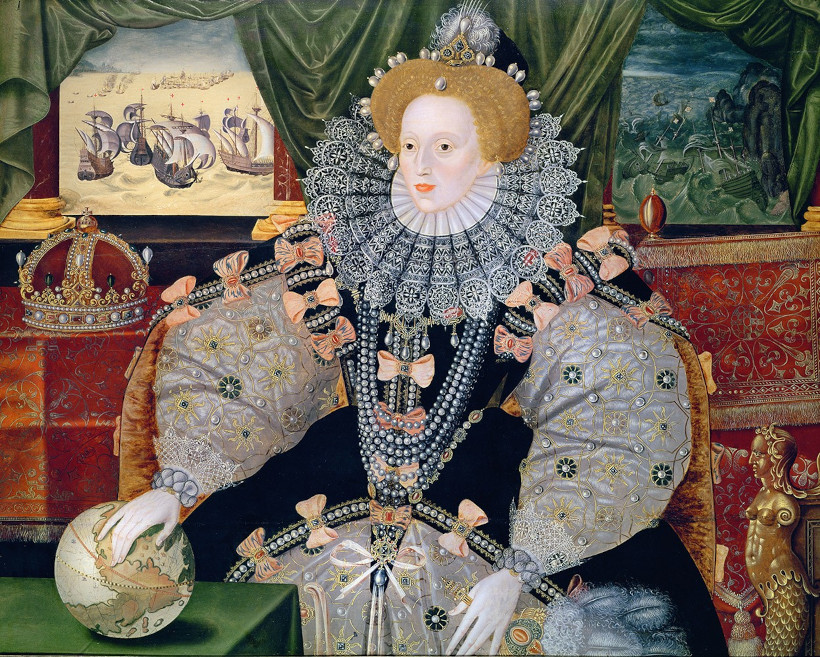
Elizabeth I
Henry VIII's second daughter then became queen Elizabeth I. She re-established the Church of
England, and attempted to maintain peace between Catholics and Protestants. She helped to
decrease the power of the nobility and replace it with a common law parliament. Scotland
became Protestant at this time. Elizabeth's reign is seen as a golden age, where a sense of
British nationality arose and England grew more powerful. Shakespeare was in his prime, and
it was an age of exploration and desire for expansion. Columbus had discovered the New World
almost a century earlier. The Spanish were even more powerful than the English, and while they were colonizing
South America, they attempted to invade England in 1588. The latter failed, allowing England
to continue to ascend. Elizabeth died in 1603 with no heir, and King James VI of Scotland was
also named king of England. Jamestown was founded in 1607, named after him. He made peace
with Spain and the relative prosperity of Elizabeth's reign continued for another few decades.

James I of England
Colonization and Plantation
Recall that Ireland had been conquered by the Normans in the 12th century. By the 16th
century, the Norman-Irish had thoroughly merged with the native aristocracy, and were no
longer amenable to England. As England began to send voyages to the New World, and engaged
in piracy on Spanish ships carrying treasures looted from the empires of central and south
America, the English saw the Irish as a savage people like the Native Americans, and sought
to convert and pacify them. The English used resistance as an excuse to confiscate land,
which was turned into plantations that the aristocracy owned and the Irish worked to
produce crops. The process began in 1556 of Elizabeth's reign, from the remaining Norman
base of Dublin. The plantations of Ulster began in the eastern part in 1571. The Munster
plantation was established in 1583, which was England's first colony, not only controlled
but settled by English people.
Munster was the model the English intended to apply in North America, initially as a base
for piracy of the Spanish. The first attempt in 1584 was called Roanoke, still during
Elizabeth's reign, along the coast of modern North Carolina. The early attempts at
settlement were ill-prepared, and the Roanoke settlers had disappeared by 1590. The story
is a curious one if you wish to research it, but I won't go down that rabbit hole here.
As we know, Jamestown in Virginia was able to survive after a rough start to say the least.
The early Jamestown settlers have been characterized as effete treasure seekers, but
certainly when the population began to grow, the majority were indentured servants. As
was the model in Munster, the aristocracy owned the land and the people they brought over
to work it took on a debt in the hope of improving their lot. The practice remained
common into the 18th century, and probably the majority of our ancestors were indents.
Like in Australia, England "transported" people they considered troublemakers to America
rather than keep them imprisoned at home, and they served indent terms. Early in the
history of Virginia the first Africans were brought entirely against their will, and
outright slavery eventually supplanted the indentured servant model. The concept of
capitalism is based on the value of human labor, and slavery obviously returned the
maximum profit. The Plymouth colony was established in future Massachusetts in 1620,
which we do have a connection to, but tiny compared to our history in Virginia. Maryland
was established in 1632 by the Calverts as a haven for Catholics, but without shunning
Protestants. In fact, the population of Maryland was mostly Protestant from the beginning.
Of interest to the British, and our ancestors, was the Dutch settling of land between
Plymouth and Virginia beginning in 1615. By 1660 the Dutch had settled all of modern New
Jersey, northern Delaware, Philadelphia and surrounding areas of future Pennsylvania, the
southeastern corner of New York (especially Manhattan), and western Massachusetts. They
called this area New Netherlands, and they called the town on the southern tip of Manhattan
New Amsterdam. In 1638 the Swedish established what they called New Sweden on the Delaware
river. Philadelphia would later be created by the English on the western side, and
Wilmington Delaware is at the northern tip of what would become that state. The area of
New Sweden was within territory claimed by the Dutch, and the Dutch ended up taking
possession of the Swedish settlements in 1655.
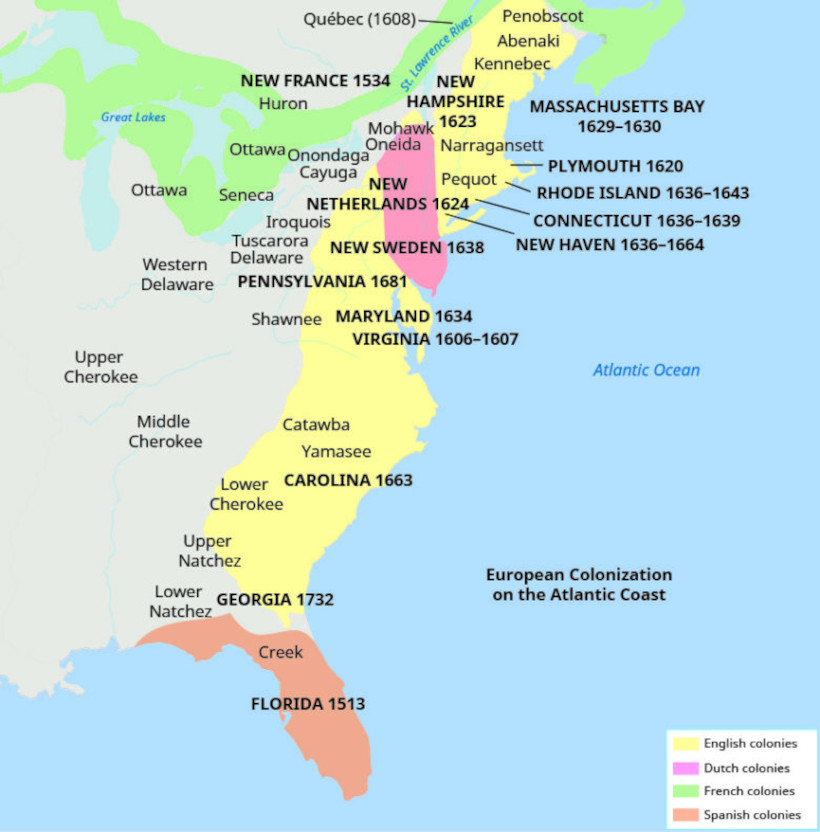
English Civil War
Back in 1625 England, King James died and his son became Charles I, king of England,
Scotland, and Ireland. Charles wed a French Catholic princess, I believe in the interest of
having peace between Catholics and Protestants, but it led only to worse antagonism. At
the same time, the Thirty Years War raged in mainland Europe, at least largely on similar
religious grounds. This was a time of rise in authority of the parliament and Common Law,
and Charles struggled to have his will as his predecessors had, when parliament acted to
restrain him. The prosperity and relative peace established in Elizabeth's reign and
through James's, ended in a big way in 1642 as the conflict between loyalists to the divine
right of the Crown and the Parliamentarians erupted in Civil War. Charles was executed in
1649, and Oliver Cromwell led the Parliamentary forces in victories in Scotland and Ireland.
Cromwell was effectively the leader of England until he died in 1658. Charles II became
king and the monarchy was restored in 1660. London was hit by a plague in 1665, and the
Great Fire in 1666.

Oliver Cromwell
A man named George Calvert was emblematic of the complexities of religious life in England.
Though he was raised with considerable Catholic influence, he lived as a Protestant through
a long career in the English parliament. He rose in power until he became the first Lord
Baltimore, taking possession of land in Ireland by that name. When he retired from the
English political scene he converted to Catholicism and invested in settlements in the New
World. This led to the foundation of the colony of Maryland, which he didn't live to see.
His sons completed the work, with Leonard Calvert becoming the second Lord Baltimore, and
Charles Calvert the third. Maryland was intended to be a haven for Catholics in America,
and yet attempted to be tolerant of Protestants. As stated before, Catholics were the
minority population of Maryland from the beginning. John Hollis was an early Protestant
settler of St Mary's, the first capitol of Maryland. He was either one of just a few
Protestants there, or more likely they were more common before the English Civil Wars
began. That conflict spilled over into Maryland, being the only colony with Catholics at
the time, in 1644. John Hollis participated in what was called Ingle's Rebellion,
betraying what I see as genuine toleration of Protestants by the Calverts, attempting to
wrest control of Maryland from Catholics. They failed, and John moved across the Potomac
to Virginia rather than swear fealty. Eventually the continual resistance against
Catholic rule in Maryland led to the Calverts themselves converting to Protestantism in
order to continue governing the colony.
English Ascendancy
Charles II's reign began with a much less powerful monarchy in the wake of the English
Civil War. Charles died in 1685 and his brother James was his heir, and he was Catholic.
When he was named King James II of England and VII of Scotland, he was then forcibly
replaced by William of Orange, husband of Charles's daughter Mary, who was Protestant.
Rebellions in Ireland and Scotland then occurred through 1745, attempting to restore James,
and after he died, his heir also named James. I've stated in the Scott document that they
were part of these Jacobite rebellions, but they were Presbyterian and would seem to have
been on the side of defending Protestants against the rebelling Catholics. I've found the
machinations that occurred impossibly confusing. Scots are often
presented as a unified force, but the truth is the highlands remained Catholic for a
long time, while the lowlands largely converted to Protestantism just after the English
did. We had a few highland Scottish ancestors who may have been Catholic, but the most
part were from the southern part of the country and I presume were predominantly
Presbyterian. The Scotts certainly were. But even so, the Presbyterians were at odds
with the Anglicans, and our immigrant Andrew, even if he was on the Protestant side, he
could've been targeted for transport to America by the English.

Charles II
Back to the developing colonies, in 1609 the Virginia colony claimed lands from modern
Pennsylvania south to below the modern southern border of Tennessee, and west to the
Mississippi River. This area covered 16 modern states. With the Spanish having claimed
Florida a century earlier, England was concerned with them expanding northward. In 1663
King Charles II granted a charter to form the colony of Carolina, or Carolana, named after
him. The original border with what remained of Virginia was a bit south of where it is
now, but was moved to the final latitude in 1665. The 1663 southern latitude of Carolina
was around modern Natchez Mississippi, and was moved more aggressively south in 1665 to
below the southern extent of Louisiana. All lands west to the Mississippi River continued
to be claimed by Carolina. Charles Town, modern Charleston South Carolina, was also
named after Charles. Settlement in the southern part was limited to the Charleston area,
and in the northern part along the coast closer to Virginia. The distance between the
populations and the difference in terrain and lifestyle, resulted in the two being
separated, eventually into the North and South Carolina colonies in 1712. Georgia was
formed from South Carolina in a similar manner to how the Carolina province had been
formed, claiming all of the future states of Mississippi and Alabama. But only the
northeast corner of Georgia was settled for a long time, mostly because of Cherokee and
Creek populations. The pressure of American settlers took until the early 19th century to
fully push them all onto the Trail of Tears to Oklahoma.
Given the broad claims of Virginia, there was friction with Maryland over what territories
were part of it or Virginia. Many of the participants in Ingle's Rebellion lived
around the Potomac and were aggrieved by their properties being given to Catholic Maryland.
Farther north, war between England and the Dutch resulted in New Netherlands being taken
over by the English in 1664. In the brief time that James II was king, the colony of New
York was named after him, as he was also the Duke of York. That's how New Amsterdam
became New York City. The colony of Delaware was organized in 1701, and New Jersey in
1702. As that process was unfolding, William Penn was granted a charter in 1681 from which
the colony of Pennsylvania was formed. It wasn't until 1767 that the final southern
border was established after Maryland had similar friction on that side. There was a
competition with New York and Connecticut over the northern border, and the southwest
corner wasn't ceded by Virginia until 1780. Now the Atlantic seaboard from Maine to
Georgia was British, and the course was set for what would become the United States.
This happened even as the British Empire expanded around the world. In Ulster the import
of so many Protestants from Scotland changed the character of the land such that it was
aligned with England and remained part of the United Kingdom as Northern Ireland when the
rest of Ireland became the Republic of Ireland in 1922.
This is a tale of the history of Britain and Ireland from the perspective of our
ancestors, so it ends with the American Revolution. I might attempt to write that up
as its own document, so it won't be here. What I think is most important to address
briefly is that it wasn't as simple a thing as we see it now. We definitely have
ancestors who were loyal to the Crown and wanted to remain British. Many loyalists,
known as Tories, fled to Canada. But not all of them. Many Tories were hung or killed
in even more barbaric ways. And the Tories weren't gentle with Patriots, either. As
with the later Civil War, choosing sides wasn't always easy. It seems pretty obvious
that anyone who didn't want a revolution and yet remained in America, kept quiet about it
and adapted. Therefore it may be impossible to know. What matters is they remained and
became American. But I do wonder if the antagonism toward secularism in this country
was rooted in them. Loyalists tended to be wealthy and owned slaves, and dynastic wealth
still has strong connections to the origins of the English colonies.

last edited 1 Dec 2022
